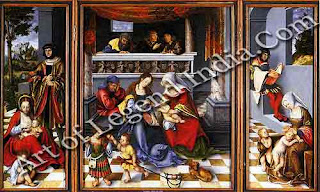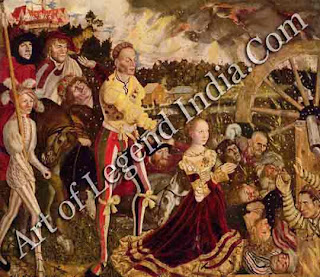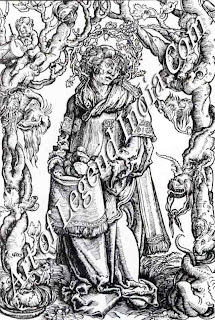'Swiftest of Painters'
As the
most prolific and versatile artist of 16th-century Germany it is impossible to
classify Lucas Cranach except by the title his talent, speed and efficiency
earned him 'the swiftest of painters'.
A great
artist of the Renaissance in Germany, Lucas Cranach was at the forefront of the
new, forward-looking intellectual currents that were undermining the traditions
of medieval Europe. Yet he spent most of his career in an isolated northern
town and was only indirectly affected by the perfect expression of those ideas
practised in Italy. As a result, his works can look quaint and provincial when
compared with those of his southern contemporaries, Giorgione or Raphael. But,
in his own context, he was just as progressive as they, and in some ways a more
individual artist, precisely because of his isolation.
Nothing
is known of Cranach's early work in his home town of Kronach, and we have to
wait until he was in Vienna and 30 years old to see anything certainly by his
hand. The wonderful Crucifixion and the woodcut of St Stephen produced in 1502,
show that he had learned a great deal from Durer while his portraits of
scholars from the university, including the rector, Johannes Cuspinian, show he
was already in intellectual circles and absorbing ideas from Italy.
 Cranach's
work at the time gained its power through a marvellous understanding of
landscape, achieved through close observation of nature and through the
expressive power of his figures. These may not be classically proportioned or
posed, but they do show an extraordinary range of dramatic gesture and action,
all learned originally from Durer's woodcuts but developed with a nervous
energy all Cranach's own.
Cranach's
work at the time gained its power through a marvellous understanding of
landscape, achieved through close observation of nature and through the
expressive power of his figures. These may not be classically proportioned or
posed, but they do show an extraordinary range of dramatic gesture and action,
all learned originally from Durer's woodcuts but developed with a nervous
energy all Cranach's own.
Once in
the service of Frederick the Wise in Wittenberg after 1505, Cranach's
independent direction became even more marked. He adapted quickly to his role
as court painter, falling in easily with the sensibilities of his patrons. The
magnificent altarpiece of 1506 depicting The Martyrdom of St Catharine, for
example, combines realism and a sensual joy in the qualities of colour, texture
and line in a most complex and animated scene.
Cranach's
state visit to the Netherlands in 1508, reinforced the influence of the Italian
Renaissance in his work. The so-called Torgau Altarpiece, for example, showing
a grouping of the Holy Family, has a more balanced composition, is less
cluttered and has figures with real weight and solidity. Presumably the artists
he met in the Low Countries showed Cranach collections of drawings and
engravings from Italy. From this time, too, we also see the first classical
subjects in his art. An engraving of 1508 has The Judgement of Paris as its
theme, with the nudity of the three goddesses introducing what would later become
the artist's most characteristic subject.

Although
excited by these developments, the bulk of his work at this time was more
conventional. Frederick the Wise's court required portraits, altarpieces and
smaller devotional paintings to decorate chapels, and these Cranach began to
produce in great number. The Elector and court could not fail to approve of
such works, which were highly finished, sophisticated and produced regularly
and to order. His portraits, in particular, showed members of the court in wonderfully
elaborate and fashionable dress.
Cranach
was not a temperamental artist who would keep frustrated patrons waiting years
for a picture to be finished, but a highly professional manager of a workshop,
proud of craftsmanship and efficiency. He clearly worked with a substantial
team of assistants, yet there are no copies among the huge output. A painting
might be done in different versions, but the master seems to have supervised
closely and participated in almost everything, correcting details and carrying
out the most difficult portions himself.
 For
portraits, Cranach would execute sketches in oil on paper from the noble
sitters who increasingly demanded pictures from him and would then use these as
a file copy from which repeated finished portraits could be produced over the
years, varying the pose and costume without the necessity of another sitting.
From 1520, this became even more necessary to meet the demand for portraits of
Luther and the Saxon princes who led the Reformation.
For
portraits, Cranach would execute sketches in oil on paper from the noble
sitters who increasingly demanded pictures from him and would then use these as
a file copy from which repeated finished portraits could be produced over the
years, varying the pose and costume without the necessity of another sitting.
From 1520, this became even more necessary to meet the demand for portraits of
Luther and the Saxon princes who led the Reformation.
SENSUOUS ENTERTAINMENT
From
the later 1520s, the artistic mood we now call Mannerism began to spread from
Italy. This signified a relaxation in the strictness of Renaissance classicism
and a new concentration on the sensuous and the entertaining aspect of
pictures. Cranach seems to have responded easily to this general trend for it
more closely reflected his own artistic temperament. His portraits,
particularly of women, became more idealized, with slender figures and small
rounded heads. Their dress, in particular hats, became ever more obvious and in
the latest fashion.

Gradually
the sensuous nude, usually representing Eve, Lucretia or Venus, assumed a
prominent place in Cranach's output. But these are no longer the classic nudes
of the Renaissance: they are idealized court beauties titillatingly hiding
their nakedness with transparent veils, or wearing jewellery or hats to
accentuate their erotic availability. Meanwhile, his workshop continued the
production line of portraits, devotional panels (now concentrating on themes
acceptable to Reformation theology), mythological scenes and altarpieces. One
of Cranach's last great works, painted in 1550 at the age of , was a
self-portrait stern and as realistic as anything he had painted. If there is
anything to be read from his unnerving direct gaze, it is pride in a job well
done.
Writer
– Marshall Cavendish
 Cranach's
work at the time gained its power through a marvellous understanding of
landscape, achieved through close observation of nature and through the
expressive power of his figures. These may not be classically proportioned or
posed, but they do show an extraordinary range of dramatic gesture and action,
all learned originally from Durer's woodcuts but developed with a nervous
energy all Cranach's own.
Cranach's
work at the time gained its power through a marvellous understanding of
landscape, achieved through close observation of nature and through the
expressive power of his figures. These may not be classically proportioned or
posed, but they do show an extraordinary range of dramatic gesture and action,
all learned originally from Durer's woodcuts but developed with a nervous
energy all Cranach's own.  For
portraits, Cranach would execute sketches in oil on paper from the noble
sitters who increasingly demanded pictures from him and would then use these as
a file copy from which repeated finished portraits could be produced over the
years, varying the pose and costume without the necessity of another sitting.
From 1520, this became even more necessary to meet the demand for portraits of
Luther and the Saxon princes who led the Reformation.
For
portraits, Cranach would execute sketches in oil on paper from the noble
sitters who increasingly demanded pictures from him and would then use these as
a file copy from which repeated finished portraits could be produced over the
years, varying the pose and costume without the necessity of another sitting.
From 1520, this became even more necessary to meet the demand for portraits of
Luther and the Saxon princes who led the Reformation. 













0 Response to "German Great Artist Lucas Cranach - 'Swiftest of Painters' "
Post a Comment